by Catherine Haug, April 10, 2011
(photos by Shelli R. & Catherine Haug)
ESP is offering a panel presentation on June 15, 2011 on Cheese Making at Home; and we offered a previous presentation by Fran W. in 2009 on (Making Cheese and Tofu).
While our panel members Fran and Shelli both use raw goat’s milk for their cheese, many of us do not have access to raw milk (it is illegal to sell raw milk in Montana). Fran discovered that store-bought Organic ultra-pasteurized milk will not curd for cheese, when she tried to make a sample for her 2009 presentation.
Now we have access to HTST pasteurized milk from Kalispell Kreamery (processed at a lower temperature than ultra pasteurized). Will it work the same as raw milk? Are modifications necessary?
(See my articles Food Safety & Pasteurization for more on the different types of pasteurization; and Cheese Making: Waxing the Round for how to preserve your cheese for storage).
The Challenge: Using Pasteurized Milk
Shelli R. and I took on the challenge, taking photos along the way. We had a few false starts, but we were eventually able to make cheese from K. Kreamery milk.
Pasteurization is a process of heating milk to the point that denatures enzymes and other proteins, to kill the microbes naturally present in all fresh milk and extend the shelf life of the milk. As Fran discovered in 2009, some types of pasteurization inhibit the ability of the milk to form curds, by denaturing the casein protein. This altered protein takes the natural milk calcium out of solution, so it is not available to curd the cheese. Here’s a summary of the different types of pasteurization and the effect on cheese:
- Thermization of milk (heated to 145° – 149° F for 15 seconds) does not alter the casein & calcium, and will produce curd for cheese;
- Vat pasteurized milk (heated to 145° F and held for 30 minutes) does not alter the casein & calcium, and will produce curd for cheese;
- HTST pasteurized milk (heated to 161 – 185° F for 15 seconds), like that from local Kalispell Kreamery; will it also require addition of calcium chloride?
- Ultra-pasteurized milk (heated to 280° F for 2 seconds) even Organic, will not curd without the addition of calcium chloride, and yields less than satisfactory results even with the addition of calcium chloride.
Pasteurized Milk Experiment:
Our recipe is Basic Cheesemaking for 1 Gallon of Milk (3), by Dr. David B. Fankhauser, Ph.D., Professor of Biology and Chemistry, University of Cincinnati Clermont College, with additional helpful information from Beginning Cheesemaking: Ingredients & Equipment (2), also by Dr. Fankhauser.
Ingredients:
Milk: We used 1 gallon of Kalispell Kreamery whole milk (HTST pasteurized).
Culture: We used buttermilk for our first test batches (2 Tbsp buttermilk per gallon milk), but switched to homemade yogurt (1/3 cup per gallon milk) because it cultures more slowly than buttermilk.
Calcium Chloride: You can purchase 30% CaCl2 solution on the internet (such as from New England Cheesemaking Supply), or you can buy CaCl2 crystals through a pharmacy or brewery supply. But we chose to have Evergreen Pharmacy compound the 30% CaCl2 solution for us, using CaCl2-2H2O (the dihydrate of calcium chloride).
To use CaCl2: For 1 gallon of milk, stir 1/2 tsp 30% solution into 1/4 cup cool water, then add to the cultured milk (we used 1/4 tsp solution and 2 Tbsp cool water for a half-gallon of milk). CaCl2 must be added before adding the rennet.
Rennet: Rennet comes in many forms, including animal-source and vegetable source rennet. We chose tablets of vegetable rennet from New England Cheesemaking Supply, but you can also find this same product at local sources.
We used 1/4 tablet vegetable rennet per gallon of milk, dissolved in 1/4 cup cool water (or 1/8 tablet for a half-gallon, dissolved in 2 Tbsp cool water). Let it rest 30 – 45 minutes to dissolve, before stirring into the cultured milk, after adding CaCl2 (if using). Then do not disturb until the whey separates, about 1 hour.
Precautions with rennet:
- Crush the tablet between two spoons then add to the water, for better dissolution;
- Wait no longer than 45 minutes for the rennet to dissolve (even if it has not fully dissolved), as longer than that weakens the enzyme;
- Let the inoculated milk rest only 1 – 2 hours before adding rennet, rather than overnight, so that the milk will be acidic but the casein not fully fermented (fermented casein can no longer be worked upon by rennet).
Method:
First we cultured the gallon of milk (using buttermilk or yogurt), then divided it into two half-gallon batches to test the effect of added calcium chloride (CaCl2) and determine if it is required for this HTST process milk.
- For the first half (with Ca), we added both CaCl2 and vegetable rennet to the cultured milk.
- For the second half (no Ca), we did not add CaCl2 to the cultured milk, but did add vegetable rennet.
Results Summary
Our first attempts failed for both batches – none would form a curd. At first we thought it was the buttermilk we used for culture, so we switched to yogurt. Then we thought it was the rennet, so Shelli tried it with raw goat milk, and that made cheese.
Finally we discovered the problem: we let the milk culture too long before adding the rennet. Dr. Fankhauser’s recipe indicates to let it culture overnight after adding the buttermilk or yogurt, so ours cultured about 12 hours, and got quite thick. We later discovered in his Ingredients & Equipment article (2) that the milk should not be cultured so long that it begins to thicken before adding the rennet.
Along the way, we tried home-pasteurizing raw goats milk (using the thermization method described above), to see what effect that has on the process to form cheese, with and without CaCl2. These batches did work, and gave us more experience and confidence with the process:
- one batch for feta without CaCl2, to test the precautions listed above for rennet;
- two batches for hard cheese (one with, one without added CaCl2), noting that the one with added CaCl2 made a firmer curd.
Our final attempt (using Kalispell Kreamery milk), we cultured only 1 hour, just long enough for it to acidify the milk for the rennet to act, but not long enough for it to coagulate (thicken). We added CaCl2 to the first half gallon only, then added rennet to both half-gallons and crossed our fingers.
The CaCl2 batch was the first to have a successful clean break, and made a firmer curd. The batch without CaCl2 also made a clean break, but had a less-firm curd that did not survive the process to set the curd (most of the curds disintegrated to hard soap-like flakes).
Conclusion
You may be able to have a successful batch without the addition of CaCl2, but we did not. We only had success with added CaCl2, and that batch made excellent cheese!
Our Process to Successful Cheese with Kalispell Kreamery Pasteurized Milk (Photo Essay)
See Making Cheese with Kalispell Kreamery Pasteurized Milk (a 4-page printable pdf file) for complete photo essay. Below are the highlights.
Inoculate the milk, and add rennet for clean break
We heated the milk to 145° F, then cooled to inoculation temperature of 20° C (68° F). Then added yogurt to inoculate, and let it rest 1 hour before adding CaCl2 and rennet. Then a rest overnight for the curd to separate from the whey, achieving a ‘clean break’.
Cut and set the curd
Using a long-handled knife, holding the knife at an angle, we cut the curd first N to S, then E to W, into 1/2″ – 3/4″ cubes,
Then we set pot over heat and slowly warmed to 34oC (92o F) for soft curd cheese. While it was heating, we stirred the curd gently with a clean hand, to set the curd. It is ‘set’ when it has the consistency of firm scrambled eggs. At that point, it is removed from the heat.
Drain & salt curd
We drained the curd in a cheesecloth-lined colander set over a bowl to collect the whey. When it was mostly drained, we tied up the cheesecloth around the curds to squeeze out more whey, before hanging it above the bowl until it stoped dripping, about an hour.
After sliding the curds from the cheesecloth into a clean bowl, we worked 2 tsp cheese salt per gallon of milk into the cheese with a clean hand.
Press & dry cheese
We scooped the cheese into a cheesecloth-lined press, then wrapped the cloth around the cheese like a ‘bandage.’ Added weight to press out more whey, thus drying the cheese. Each day (for 6 days), the cheesecloth was removed to rub more salt over outside of the cheese, then re-wraped in a fresh bandage and return to press with weights.
After the 6th day, it had not yet formed a yellow rind, so we continued the salting and rebandaging until the 10th day, when we decided it was ready for the next step, because we wanted to have a semi-hard, waxed cheese for the Cheesemaking gathering on June 15.
- As a soft cheese, it was ready.
- For a semi-hard cheese, it should be dipped in melted wax and stored in refrigerator to age about a month.
See Cheese Making: Waxing the Round (post) or Cheese Making: Waxing the Round (3-page pdf) for photo essay of the waxing.
References, or for more information
- ESP articles: Food Safety & Pasteurization; Making Cheese with Kalispell Kreamery Pasteurized Milk
- Beginning Cheesemaking: Ingredients & Equipment, by Dr David B. Fankhauser, Ph.D., Professor of Biology and Chemistry, University of Cincinnati Clermont College
- Basic Cheesemaking for 1 Gallon of Milk, also by Dr. Fankhauser
- Cheesemaking Recipe for Chevre, also by Dr. Fanhauser
- Cheesemaking Recipe for Feta, also by Dr. Fankhauser
- Rennet Preparation (from a ruminant stomach), also by Dr. Fankhauser
- About Cheese Making, by Leeners (a menu of cheesemaking topics)
- How to Use Rennet in Cheese Making, by Leeners
- New England Cheesemaking Supply Co.: cheesemaking.com
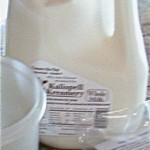
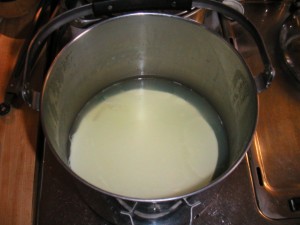
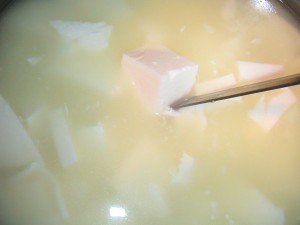
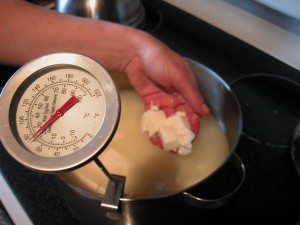
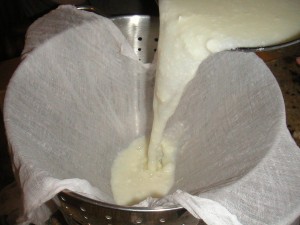
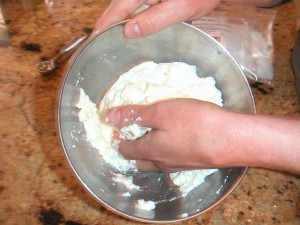
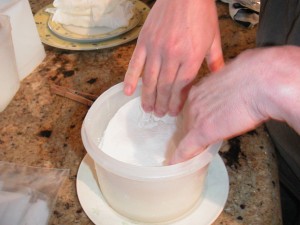
I am glad that you worked out the problem with the curd not forming. A few people have given up and assumed that our milk will not make cheese. We reassure them that it is HTST pastuerized and can make cheese(and makes good cheese due to non-homogenization). I will now inform them of your findings hopefully it will help them.
Thank goodness I found this post. I have been SO FRUSTRATED! I have followed Dr. Fankhauser’s recipe for cheese over and over with failed results each time. I have given up to try again months late only to fail again. Now I know how correct my mistakes and make great cheese….finally! I’ll try this today and report back !
Thanks girls!